David Thomas Tully
Blocks 39, 52A, 52B Belconnen District & Block 43 Stromlo District
David Thomas Tully was born in 1894 at Duntroon where his father, David Tully Snr., was the station manager. Around 1903, the family moved to their own property called The Springs, near Captains Flat, NSW. After finishing school, Tully was sent to study wool classing at Sydney Technical College.
Tully enlisted in 1915, shortly after his 21st birthday, and served with the 2nd Battalion on the Western Front from May 1916. During the following twelve months, the 2nd Battalion was involved in some of the fiercest battles of the war at Pozières, Mouquet Farm, Flers and Bullecourt. Tully's war ended in May 1918 when he was shot in the elbow and sent to hospital at Netley in England for treatment.
Belconnen Block 52A
In October 1920, David Tully applied for a Soldier Settlement block. On his application for land, he described himself as being 26 years and six months of age, single and a wool classer by profession. He had a war bond worth £84/7 and cash of £17 in assets.
Despite being unsuccessful in two previous land ballots in early 1920, he was allocated his sixth choice, Belconnen Block 52A. The block extended to both sides of the Molonglo River, just upstream from Coppins Crossing, and was advertised as being 587 acres (238 hectares) in size. Tully's lease was for five years beginning on the 10th November 1920 at an annual rental of £183/6/8.
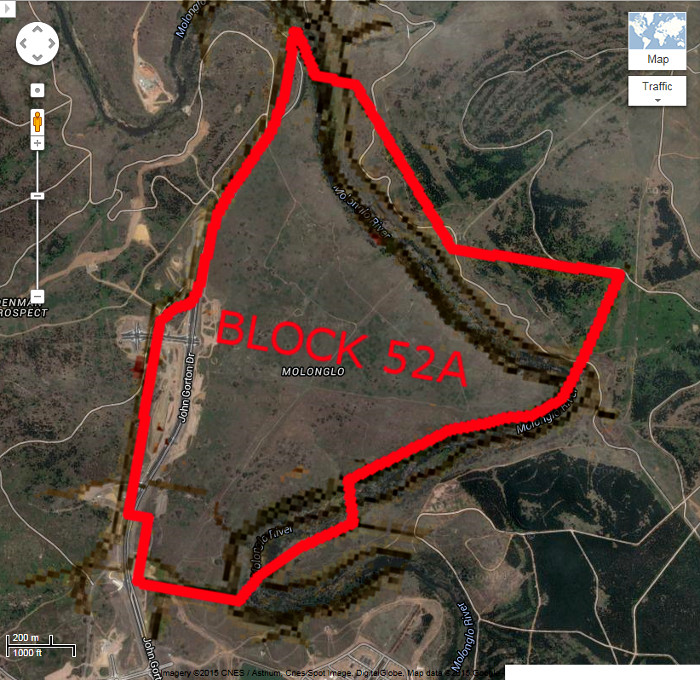
Google Maps image of area c2014 with the original Belconnen Block 52A boundary in red.
By August 1922, Tully was looking for more land as his block was insufficient to make a living. It was then officially described as being "about 580 acres" (235 Hectares) on which he had stock of 544 sheep (mortgaged to the Commonwealth) and progeny of some 380 lambs from the 1922 season. Tully wanted urgent relief as his sheep were dying due to drought.
By January 1923, Tully was living on the block, probably in an old house referred to as "Mrs. E. Blundells House" on pre-war maps. However, he had yet to sign a lease, possibly because the land had not been properly surveyed. In April 1923, the District Surveyor reported that "there seems to be some doubt as to the values of the boundaries of Block 52A." A few months later, surveyor Freddie Johnston produced a report showing that the block was actually 849 acres (344 hectares) in size, which included 49 acres (20 hectares) of the Molonglo riverbed.
The Commonwealth Surveyor General, Colonel John Goodwin, finally forwarded the lease to Tully to sign in September 1923. Goodwin noted that the block was "considerably in excess of the area which you were paying rent for" and that there were arrears in rent of £134/9/11. Goodwin requested the arrears be paid when the signed lease was returned, which was something of a surprise to Tully. Tully argued that he had stocked the land according to the area shown on Commonwealth maps and during the 1922 drought, he had sold some of his sheep at less than cost price. He requested that he be given two years to pay the arrears, as his income was insufficient to pay it in one lump sum. Tully finally signed the five year lease on the 6th June 1924, the lease actually commencing on the 10th November 1920.
Belconnen Block 52B
In November 1920, Belconnen Block 52B was allocated to Maurice Fergusson. His five year lease on the 682 acre (276 hectare) block commenced on the 10th November 1920. However, Fergusson sub-let the block without approval from the Commonwealth, a breach of the lease agreement. Fergusson's lease was determined with effect from the 9th November 1922.
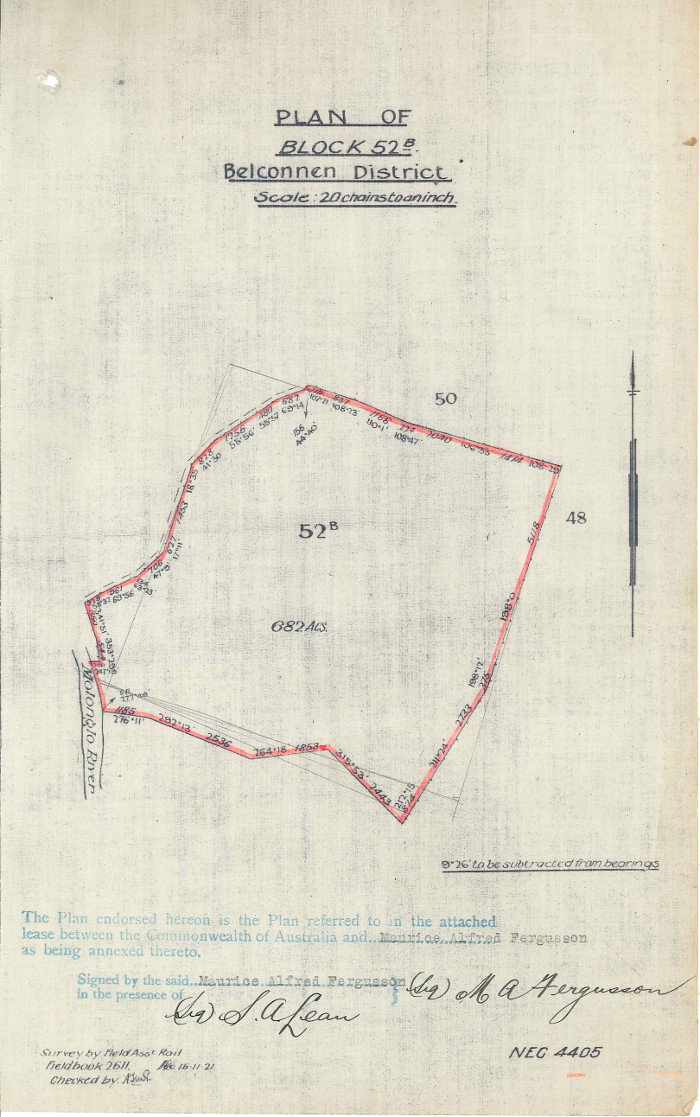
Plan of the original Belconnen Block 52B.
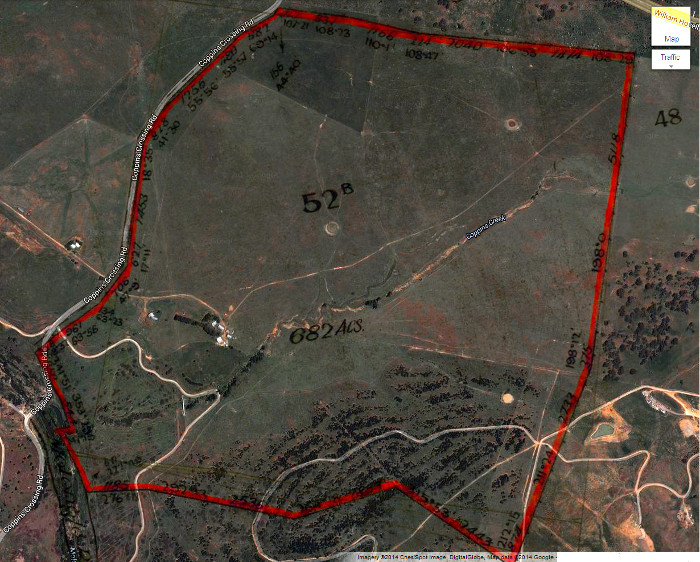
Google Maps image of area c2013 with the original Belconnen Block 52B boundary in red.
In January 1923, District Surveyor Percy Sheaffe opined that because "Block 52B formerly leased to Fergusson of 682 acres (276 hectares) was enclosed with Tully's lease in one group of netting", it should be offered to Tully until the 9th November 1925 when his lease on Belconnen Block 52A expired. Sheaffe stated that Tully "appears in every way a very promising and deserving lessee."
In 1926 the Lands Officer of the Federal Capital Commission (FCC) recommended that Tully's leases be terminated because blocks of land in the area were being redesigned. The new block, designated as Belconnen Block 52B, incorporated the entire original Block 52B and most of Block 52A. Some land south of the Molonglo River was lost becoming part of Woden Block 15. The new Belconnen Block 52B was 1296 acres (524 hectares) in area and was essentially the Mowatt and Coppins Corner Paddocks from the old Yarralumla estate. Tully's lease ran from the 1st January 1927 until the end of 1935 at an annual rental of £307/16.
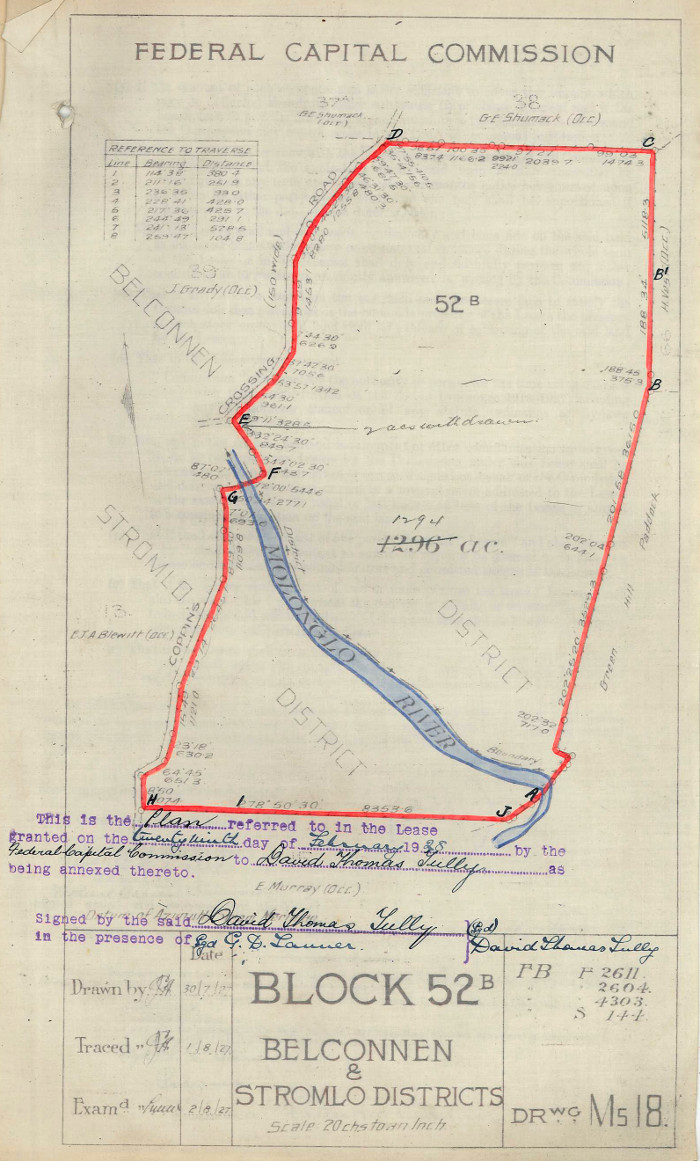
Plan of Belconnen Block 52B after merging with Block 52A in 1926.
In 1929, Tully built a new residence using a Housing Ordinance (1928) loan of £585 repayable over six years. He also built a woolshed and attached men's quarters just off Coppins Crossing Road. However, by the following year he was feeling the impact of the Depression and owed rental arrears and penalties of £320/9/6 on his leases.
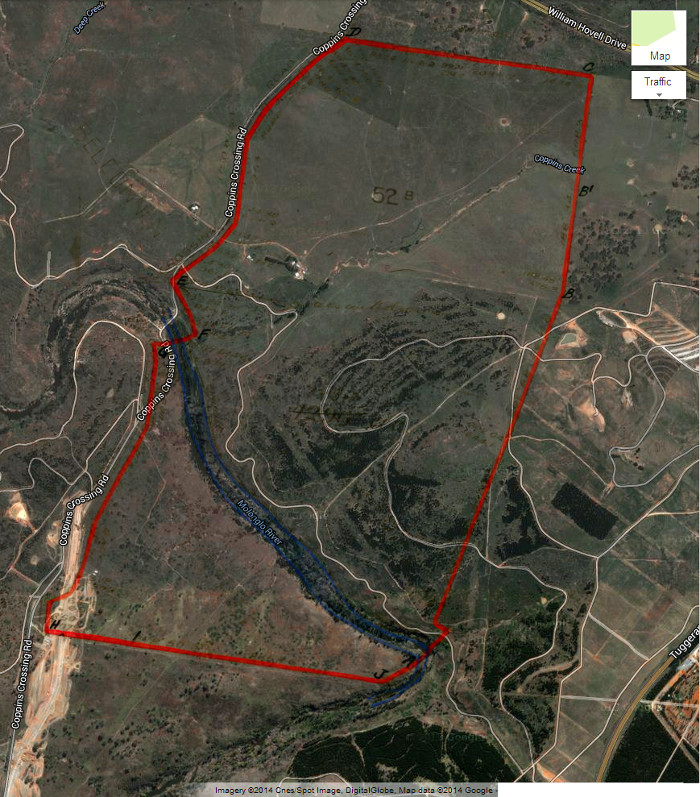
Google Maps image of area c2013 with enlarged Belconnen Block 52B boundary in red.
Belconnen Block 39
In 1923, Jim Grady successfully applied for a ten year lease on Belconnen Block 39 of 563 acres (228 hectares). It had frontage to the northern bank of the Molonglo River while Coppins Crossing Road formed its eastern boundary. Despite Tully's financial difficulties in the early 1930s, he agreed to purchase Belconnen Block 39 for £360 from Grady in August 1931. The transfer proceeded on the 23rd March 1932 giving Tully just over 1800 acres (728 hectares) of land.
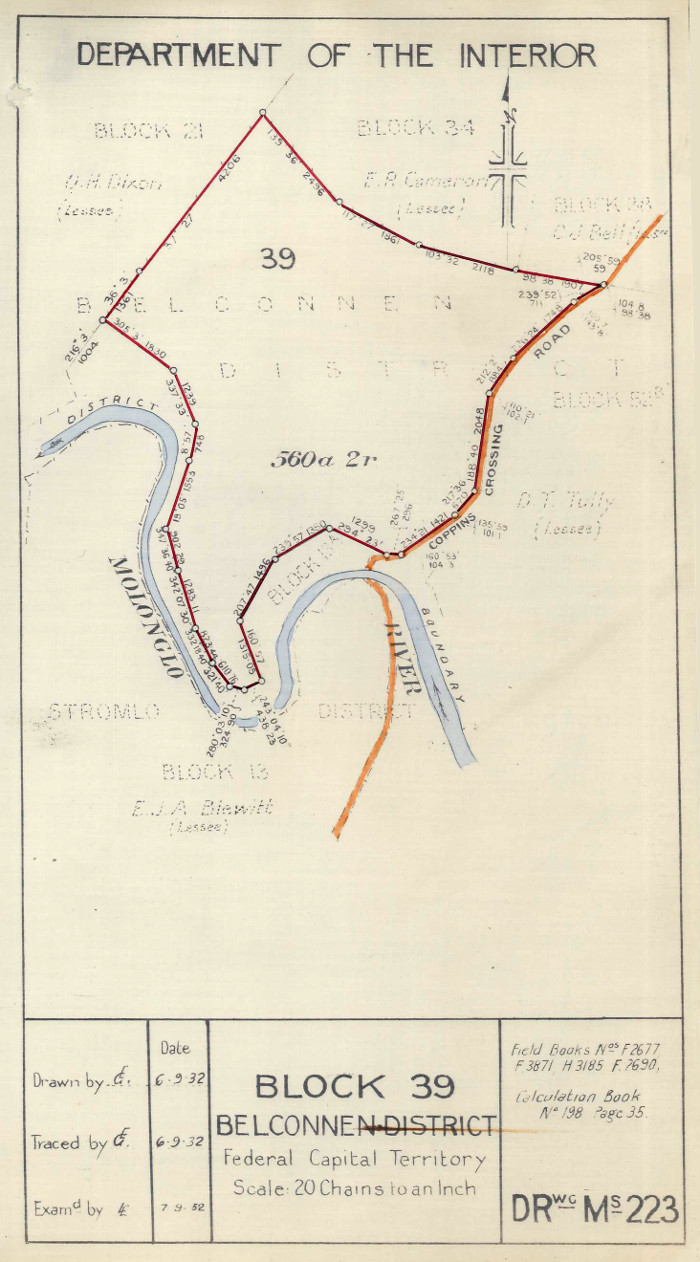
Plan of the original Belconnen Block 39.
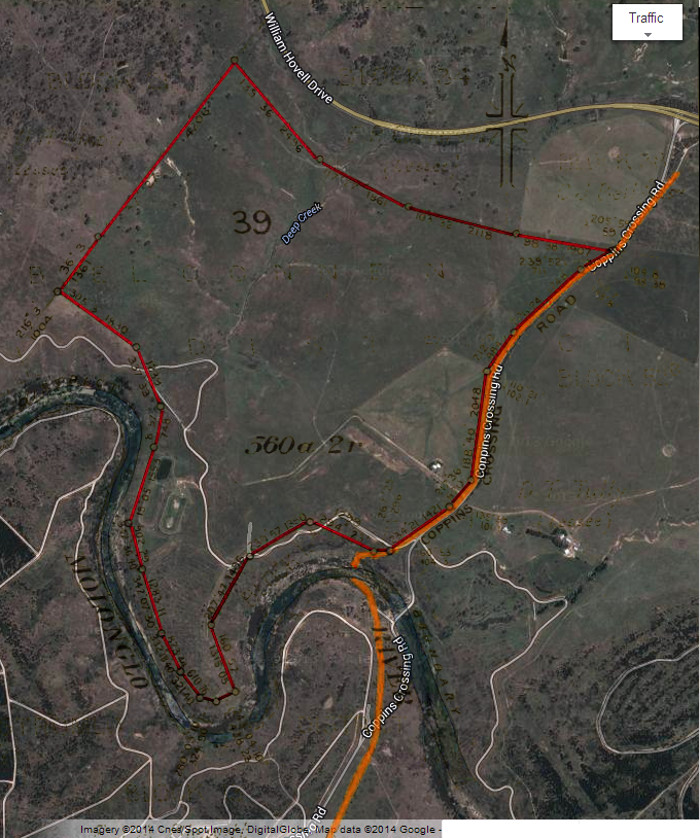
Google Maps image of area c2013 with the original Belconnen Block 39 boundary in red.
On the 1st July 1933, Tully consolidated Belconnen Blocks 39 and 52B into one lease. This larger block designated Belconnen Block 39 had an area of around 1800 acres (728 hectares).
Block 43 Stromlo District: Property Name: 'Netley'
There were two distinct parcels of land designated as Stromlo Block 43, though not at the same time. The first Stromlo Block 43 was allocated to Hilton Clothier in 1920 but was resumed at the end of 1925 for a pine plantation on the slopes of Mount Stromlo.
The second iteration of Stromlo Block 43 occurred in August 1934. Tully's leases of Belconnen Blocks 39 & 52B were consolidated into two new blocks, Belconnen Block 39 and Stromlo Block 43. The 1517 acres (614 hectares) on the northern side of the river, bisected by Coppins Crossing Road, remained as Belconnen Block 39. The 290 acres (117 hectares) south of the Molonglo River was designated Stromlo Block 43.
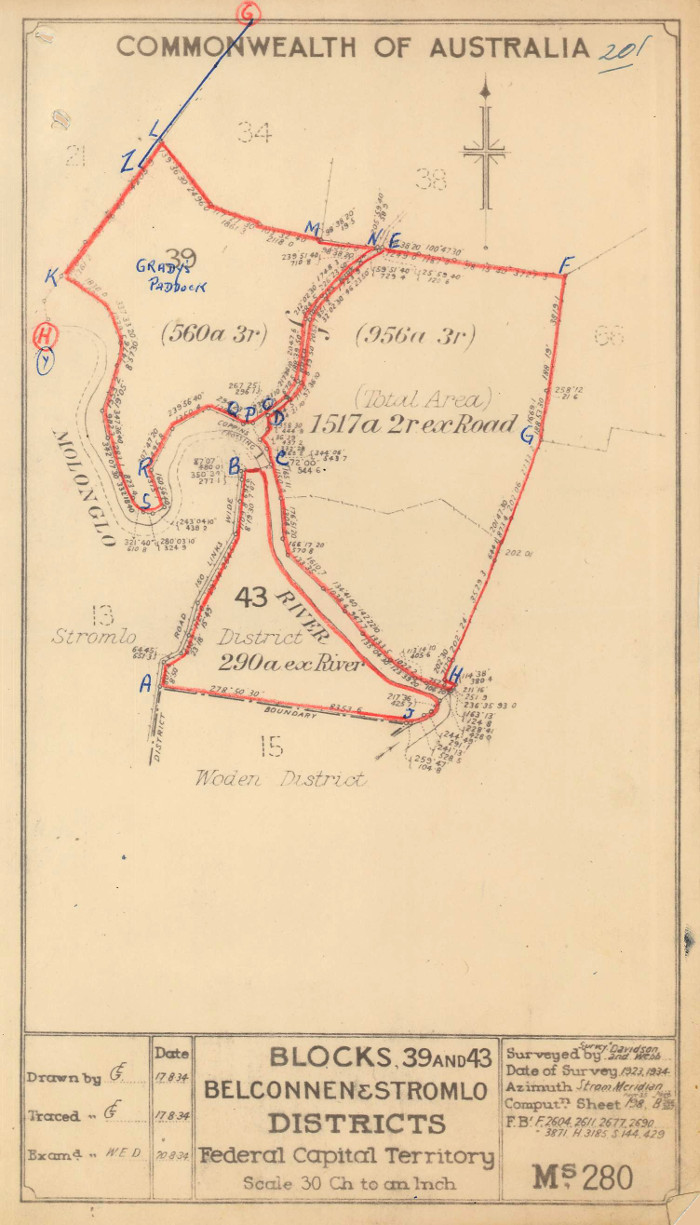
Plan of Belconnen Block 39 and Stromlo Block 43 after 1933 redesign.
Tully’s Block 43 had been part of the Yarralumla estate known as the Coppins Corner Paddock when the Federal Capital Territory (FCT) was created in 1911. Coppins Crossing Road bordered the block on the west, the Molonglo River on the north and east and by Woden Block 15 on the south. It was also where Tully built his new residence in 1929 which was a three room cottage with a kitchen, front and rear verandahs and an iron roof.
Some sources refer to the property as The Rivers but this name was used by Tully's neighbour, Aubrey Blewitt, for Stromlo Block 13. Other evidence, including the brand Tully used on his sheep ('DT Netley') and correspondence addressed to him (at 'Netley, Urriarra Road'), implies that the property was called Netley. Netley was the name of the hospital in England where Tully was treated for wounds in May 1918. It was there that he developed a passion for flowers, something which played an important role in his later life.
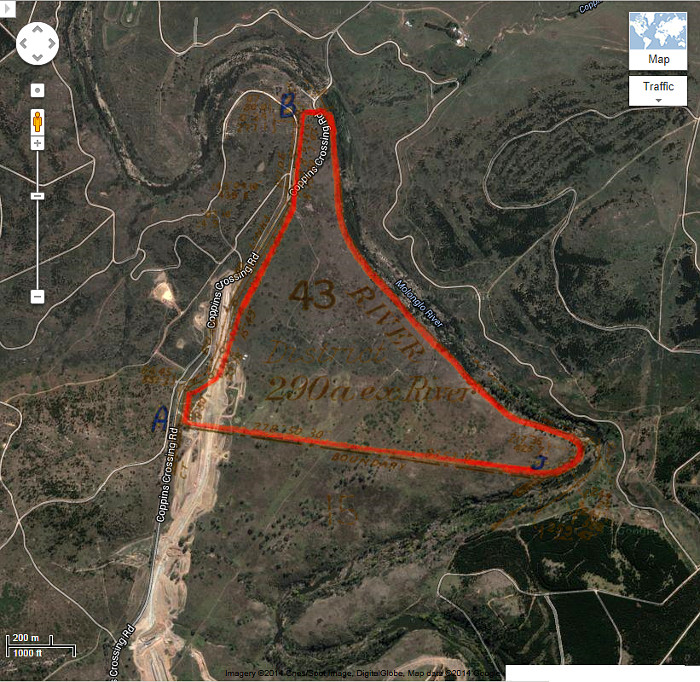
Google Maps image of area c2013 with Stromlo Block 43 boundary in red.
In 1935, Tully married Una Bellamy who worked at the Canberra Community Hospital. They lived in the cottage on Stromlo Block 43 but, with a growing family, Tully decided to sell his property. In late 1941 the Canberra Dairy Society (CDS) was looking for a long term lease to agist stock. The CDS held a short term lease on the neighbouring Belconnen Block 47 but had been advised that it would be required for a pine plantation. Today, Belconnen Block 47 is the site of the National Arboretum. Tully and the CDS agreed on a price of £6000 for both Belconnen Block 39 and Stromlo Block 43. They were transferred to the CDS on the 16th February 1942.
Tully and his family moved to Oxley Street in Griffith and he operated a timber mill at Kingston. Around 1951, he sold his home and business and became manager of Glenwood, a property near Hall. He eventually moved to Wellington, NSW where he became known as the 'Little Flowerman'.
David Tully died on the 29th October 1972 at Bundawalla Hospital in Wellington. His ashes were spread by his children, according to his wishes, "above the crossing where my garden used to be on the Molonglo River at Coppins Crossing."
Sources
- ArchivesACT: Government Property & Tenancy Registers - Belconnen Block 39 & Stromlo Block 43 (
 PDF 332Kb)
PDF 332Kb) - ArchivesACT: Rate Book : Territory for the Seat of Government - 1927 (
 PDF 17.8Mb) - 1928 (
PDF 17.8Mb) - 1928 ( PDF 18.7Mb) - 1929 (
PDF 18.7Mb) - 1929 ( PDF 8.88Mb)
PDF 8.88Mb) - ArchivesACT: TL993 (Part 1A) - Block 52B Belconnen - D.T. Tully
- ArchivesACT: TL993 (Part 1B) - Block 39 Belconnen District - D.T. Tully
- ArchivesACT: TL993 (Part 2) - Block 39 Belconnen - Block 43 Stromlo - Graziers Pty Ltd
- ArchivesACT: TL6591 - Block 15 Woden - D.R. Tully
- NAA: (A1) 1931/2118 Grady transfer lease Block 39 Belconnen
- NAA: (CP326/8) 7 - D T Tully Block 52A Belconnen District
- NAA: L1926/1635 Block 52A Stromlo
- NAA: (B2455) First Australian Imperial Force Personnel Dossiers, 1914-1920: http://discoveringanzacs.naa.gov.au/browse/person/366543
- D Gault collection - Canberra & District Historical Society
- Shepherd’s Journey - Tully Family History by D. Duckett and M. Robson (2000) Images
- Canberra Special Stock Sale' & 'Auction Sale of Farming Plant, Etc. The Canberra Times, 17th February 1942, p.3: http://nla.gov.au/nla.news-article2564492
- ACT Memorial - Tully, David Thomas: http://www.memorial.act.gov.au/person.php?id=3122
